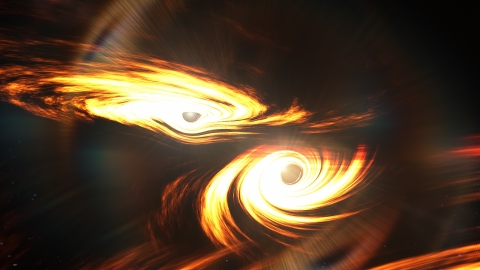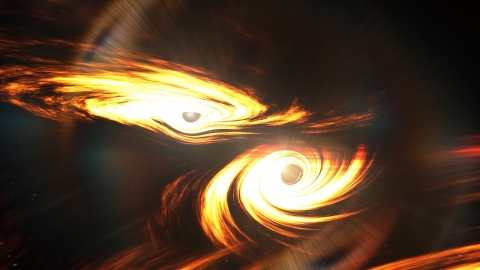

Experts from the University of Portsmouth have contributed to major international research on black holes.
2 September 2020
The most massive gravitational-wave source yet has been detected – a binary black hole merger, which produced a blast equal to the energy of eight Suns, sending shockwaves through the universe.
Gravitational waves are produced when an extreme cosmic event occurs somewhere in the universe and, like dropping a rock in a pond, these events ripple across the cosmos, bending and stretching the fabric of space-time itself.
Since gravitational waves were first detected in 2015, from the merger of two black holes more than a billion light years distant, astronomers have witnessed a slew of signals from different cosmic collisions. Together these events have opened an entirely new window on the universe that offers a unique and powerful probe of the most extreme cosmic phenomena.
This time, researchers believe the gravitational wave detectors have picked up the signal of the most massive black hole merger yet to be observed. The collision involved two inspiralling black holes, the first about 85 times as massive as the Sun, and the second measuring about 66 times the Sun’s mass.

This is the first time we have detected gravitational waves from the collision of such massive black holes – 85 and 65 times the size of the Sun.
Dr Laura Nuttall, Senior lecturer at the University of Portsmouth
When the two giant, spinning black holes smashed into each other, it created a behemoth black hole – with a mass of about 142 Suns, and a short burst of gravitational-wave energy equivalent to the mass of around eight Suns. The remnant black hole is the first clear detection of a so-called “intermediate mass black hole”, with a mass between 100 and 1,000 times that of the Sun.
It also appears the signal came from a source about 17 billion light years from Earth, making it one of the most distant gravitational-wave sources detected so far.
The signal, named GW190521, was observed on 21 May 2019 by the Virgo detector in Italy and the twin detectors at LIGO (Laser Interferometry Gravitational-Wave Observatory) in the United States – which is partially-funded by the UK’s Science and Technology Facilities Council, part of UK Research and Innovation (UKRI).
The international team of scientists - including experts from the University of Portsmouth - who make up the LIGO Scientific Collaboration (LSC) and the Virgo Collaboration, have reported their findings in two papers published today.

Artist’s impression of binary black holes about to collide. Image credit: Mark Myers, ARC Centre of Excellence for Gravitational Wave Discovery (OzGrav).
Professor Alberto Vecchio, Director of the Institute of Gravitational Wave Astronomy, University of Birmingham, said: “When stars are too massive they blow up completely when they collapse, leaving nothing behind. A black hole of 85 solar masses should not exist. This is a beautiful discovery and a fascinating puzzle. Now we need to figure out how nature could have possibly assembled such an object.”
Based on how we understand the internal workings of stars, scientists believed that a black hole of this mass could not be formed by a collapsing star. So now, with firm evidence that such massive black holes do exist, astronomers need to rethink what is known about how black holes form.
Professor Stephen Fairhurst, Director of the Gravity Exploration Institute, Cardiff University, said: “Once again, the latest gravitational wave observation challenges our understanding of the universe. We have observed the merger of the most massive pair of black holes to date, including one which is too massive to have formed directly from the collapse of a massive star. Future observations will tell us how common these massive black holes are, and provide further clues to their origins. However, they’re also sure to provide new and unexpected observations to challenge our theories in new ways.”
Dr Laura Nuttall, who is a member of the LIGO Scientific Collaboration, a UKRI Future Leaders Fellow and a senior lecturer at the University of Portsmouth, said: “GW190521 is an extremely exciting event. This is the first time we have detected gravitational waves from the collision of such massive black holes – 85 and 65 times the size of the Sun.
This is a beautiful discovery and a fascinating puzzle. Now we need to figure out how nature could have possibly assembled such an object.
Professor Alberto Vecchio, Director of the Institute of Gravitational Wave Astronomy, University of Birmingham
“What is particularly intriguing is the size of these black holes. Up to now, all the black holes that LIGO/Virgo have seen can be explained by the collapse of a massive star to form a black hole. But you can't produce a black hole that is 85 times the size of the sun this way, due to a phenomenon called 'pair instability'. This phenomenon means that collapsing stars, no matter their size, will not produce a black hole between 65 and 120 times the size of the Sun. So how did one of our black holes form?”
The UK Government, through STFC, helped to fund the upgrades carried out between 2010 and 2015 that turned initial LIGO into Advanced LIGO, and enabled the first ground-breaking detections to be made. The UK is also investing in the upcoming phase of further improvements (2020-2025) that will upgrade Advanced LIGO to Advanced LIGO+ and which will greatly improve the sensitivity of the detectors to allow even more detections to take place. This next phase of improvements will be funded through UKRI’s Fund for International Collaboration, which aims to enhance the UK’s excellence in research and innovation through forging new bilateral and multilateral research and innovation programmes with global partners.
Professor Sheila Rowan, director of the University of Glasgow’s Institute for Gravitational Research, said: “One of the lessons we’ve learned since the first LIGO observing run is the importance of being able to pause occasionally to upgrade the instruments and improve their sensitivity, because the return on that investment of time in the form of new science is tremendous. It translates into more detections, an improved rate of detections, and also detections of individual events made at higher sensitivities. That enables detections like this one, where the very low frequency of the signal might well have been impossible to pick out of the background noise without our improvements.
“It’s an exciting preview of the kinds of science we can look forward to as we continue to develop the new field of gravitational wave astronomy.”
The detections were only made possible by combining UK innovations in technology, sustained international funding, and enormous dedication and hard work by more than a thousand scientists from around the world. The LIGO Scientific Collaboration comprises over 1,300 scientists from 18 countries, and includes researchers from 11 UK universities (Glasgow, Portsmouth, Birmingham, Cardiff, Strathclyde, West of Scotland, Sheffield, Edinburgh, Cambridge, King College London and Southampton).
